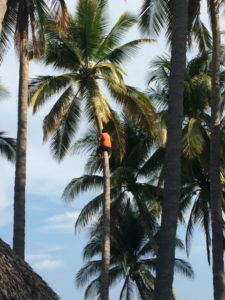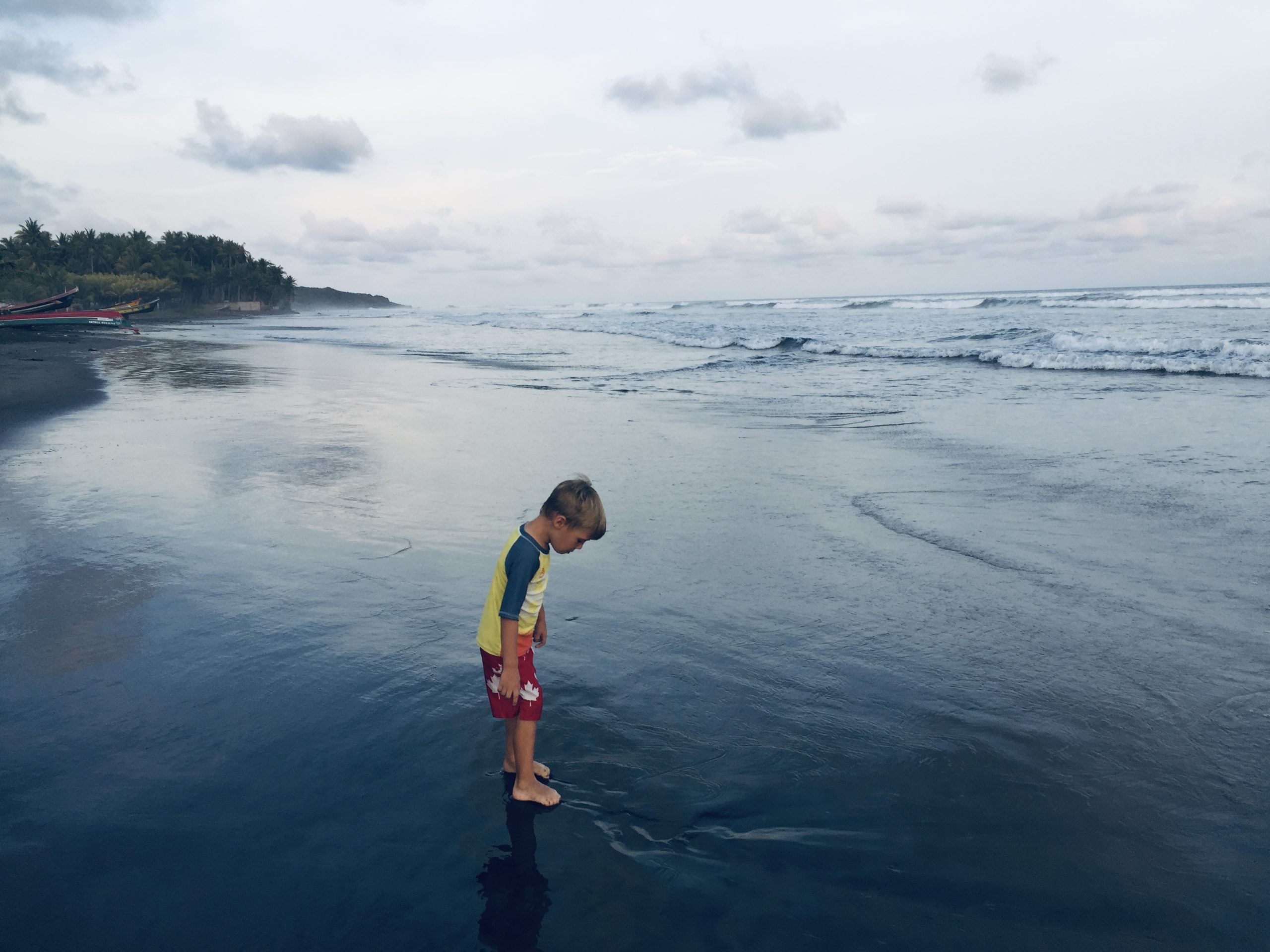Road Trip: Playa Del Cuco
We cannot travel very far these days, due to COVID-19 restrictions. All these quarantine rules are making me a little stir crazy. I felt the same way when living in Honduras. I wanted to get out and explore. For me, travel is the thrill of discovering new sounds and smells, admiring jaw dropping views and experiencing amazing events. I am addicted to getting lost is a new city. Discovery with a capital D. You stumble upon the perfect moment that you want to bottle up and save forever. Here is a description of our road trip to the town of Cuco in El Salvador which we visited in June 2019. Find yourself a comfy spot, prepare a warm drink and let yourself be transported through my memories to the beach of El Cuco.

Road Trip
Roughly 250km separates our adopted city in Honduras from the rugged beach town in El Salvador. We drove caravan style with our friends Eduardo and Claudia, fellow diplomats on posting from Columbia. For comfort and safety, our two Honda CRVs followed in tandem round the sharp turns and towards to sea. It took us half a day of driving along winding roads which narrowly hugged steep cliffs winding through the mountains to arrive at our destination. At the border crossing, our passports were stamped in less than 15 minutes and we were allowed to travel south (as opposed to the migrant caravans going north away from the infamous “triangulo del norte.”)
Finally, we can see the ocean! The GPS instructs us to take the sandy path along the beach in order to reach our accommodation for the weekend. However, we are instructed by a local passing by that it is not safe to continue by car. It is the end of rainy season and the shortcut is swamped under water. Since the kids have been cooped up in the car all morning, I suggest the men drive the detour while Claudia, the children and I walk the ocean route.

Scenic Ocean Route
We step out of the air-conditioned car into hot and very humid air. I sigh as I watch and listen to the lovely waves gently crash on the shore. Pretty pink and grey seashells wash up on the sand. The large leaves on the tall palm trees up above our heads are gently swaying in the wind. We spot a bright green lizard running up the trunk of a palm tree, my kids stop and stare at it for a good 15 minutes.
“Vamos a la playa!” exclaims Bea as she struggles to strip off her shorts and t-shirt.
“Ugh! There is sand in my sandals” laments my son shaking his foot vigorously. He refuses to walk any further. Eventually, the promise of fresh coconut water gets him moving begrudgingly towards our final destination.
The first building we pass is a grey derelict hut. We continue walking at toddler pace observing the scene unfold as walk along the beach. Soon enough, we notice a building that looks like the photos on the post we rented through Airbnb. The two blue Honda SUVs parked side by side in front of the building confirm that the men have beat us to it. The problem is the river in between us and the hotel. More precisely, we are faced with a brown swamp of stagnant water separating us from our final destination. “Un rio de chocolate mama!” Yes, Tristan, this river is made of chocolate.
The closer we get, the stronger the smell and the dirtier the water appears. I swat away at the flies buzzing around us. Now the children are also scrunching up their noses in disgust. We spot a couple logs propped up in the water: it looks as if someone has set up a makeshift bridge through the swamp-river. The logs are too far apart and since we are carrying the children piggy back style, it is impossible to not to walk in the water. I hold my breath and gingerly take the first step; the tepid muck immediately seeps into my sandals and oozes through my toes.The brown river is so dirty and mud so thick that we can’t see the bottom to guess how deep it might be. There is garbage floating nearby: plastic bottles, old diapers, empty chip bags. I walk as fast as I can through the water with my son on my back and make it to the other side.

Ocean View with Pool
We arrive at our nice hotel which has excellent customer service. From our second story window, I can see a charming sandy beach with pleasant waves for splashing and frolicking. The children quickly spot our private pool and immediately start stripping off their clothes -demanding to go for a swim. We are attended to night and day by a waiter, cook and night watchman. They are all very chatty and friendly with us. There were not many other tourists about. Hopefully our stay brings some extra income to the village.
The children spotted empty coconut shells by the beach and started asking for coconut water. We inquired at the snack-bar and this is how we came to know The Coconut Man.
The expert was summoned by phone to our hotel. He arrived on his flashy noisy motorcycle. We are told that he is the local expert who climbs palm trees barefoot in order to harvest the fruit. He does this with solely a rope around his waist, a machete and insect spray. He uses a simple rope tied around his waist and looped over his arm to hoist himself up the trunk of the palm tree. Then he uses his whole upper body strength to climb the equivalent of four stories to the very top of the coconut tree. The insect spray is to ward off poisonous snakes who like to hide amongst the palms. The Coconut Man then adeptly cuts away some old branches with his machete- releasing the bunch of ripe round green fruit -which he lowers to the ground on the end of the rope.
A wack of the machete opens the top of the coconut and we are each handed a straw. The cool fresh coconut water is delicious. Another wack with the ubiquitous machete and we are able to scoop out the coconut flesh with an integrated coconut spoon. Mmmm! Thank you Coconut Man.

Walk in town
After a dinner of fresh seafood and rice we decide to walk through the village towards the sea. We follow a dirt path with deep holes filled in with volcanic rock which has a different hollow, empty feel underfoot. The small huts are pushed up very close to the road. There aren’t any tall walls or barbed wire here, just palm trees and rusty boats. It allows the children and I to observe the everyday life of our new neighbors up close. We came to Playa El Cuco for a weekend getaway from Tegucigalpa but this is their everyday life.
While their mother washes the dishes in the outdoor sink, two young children are running barefoot after a tatty old soccer ball.
Bea exclaims: “No tiene zapatos mama.
-Si, que triste.
-Que triste, mama. »
I observe that the boy with no shoes isn’t much taller than my two-year-old daughter. The child she watches has open sores on his feet. I worry about the swampy river (that we crossed earlier) which a haven for mosquitoes and all the illnesses they carry. Behind our hotel is an enclosure with cows out to pasture. At times, we see the livestock strolling along the beach. It’s better than hawkers selling tourist trinkets, I suppose.
The neighboring huts are made with mud bricks under corrugated metal roofs. I imagine it must be stifling hot inside with the in the hot sun and 30C humidity. (That night, we discovered first hand that tin roofs are very noisy when it rains.) The windowless shacks sit upon beaten earth floors which the women constantly sweep and clean.
We walk by an old man sitting on a hammock chatting with neighbor, a guitar propped on the palm tree nearby. I start singing “Old MacDonald” softly as we walk past chickens and their chicks pecking at bugs and grass in the sand around the shack. Next door we spot two fat muddy pigs wandering in the garden. The pigs are eating mangoes left to rot on the ground. (My mind flashes back to delicious pork and mango salsa dish I ate Chez Arno, a French restaurant, in Tegucigalpa.)
We round a bend in the road and stumble upon another little boy sitting squashed into a bucket full of soapy water. Is he having his weekly bath I wonder to myself. He fixes us for a long time with his intense gaze and he seems as surprised as we are to see him.

Fish in the Sea
The next morning, we rise with the sun and walk to the beach to watch the fishermen return from the sea. Ostensibly, they were out all night. The villagers help each other bring a medium size wooden row boat back to shore. I calculate that the catch of the day is a cooler full of small to medium size fish. Next, a man with big fancy watch comes to help bring in the boat. He collects the fish from the fishermen. In all likelihood, he is the middle man who then drives into the town to sell the seafood at the local market.
In the afternoon, I watch some of the same fishermen cast their small nets from the shore. None of them are carrying anything bigger than a medium size cloth purse on their shoulders. They prance and run after the fish they spot jumping in the ocean waves. It looks like they are dancing with each other in the water. One man has a live fish in the end of a long fishing line which is then wrapped around a wooden block. “What are you doing?” my 4 year old asks, fascinated. “I’m trying to catch a bigger fish” he replies.

I wonder what impact reduced tourism (due to the present travel restrictions) has had on this village and all the others that rely on tourists from abroad. We know that the migrant caravans have set off again towards the North. The local wildlife has also been affected by the reduction in tourism.
I hope this short piece allowed you to arm chair travel. Notwithstanding the enormous disparities between my children and the local kids at Play Del Cuco, El Salvador, we should always strive to savour the moment of the time and the place we live in at the present.

Yes, it was a beautiful arm chair trip. Beautiful! Merci!
Very evocative. Best one yet.
Thanks for the arm chair travel!!!